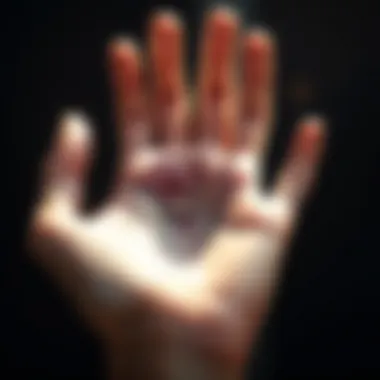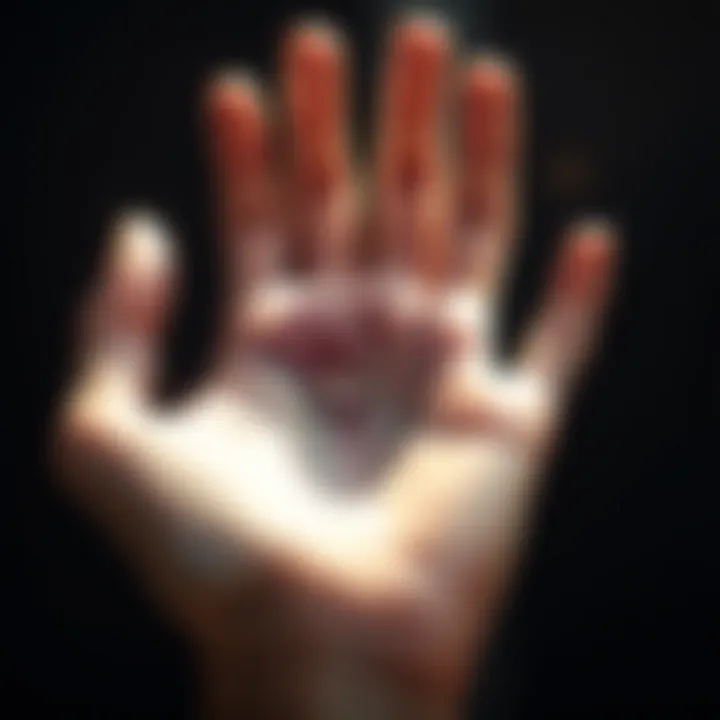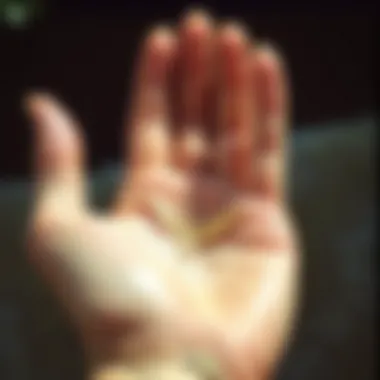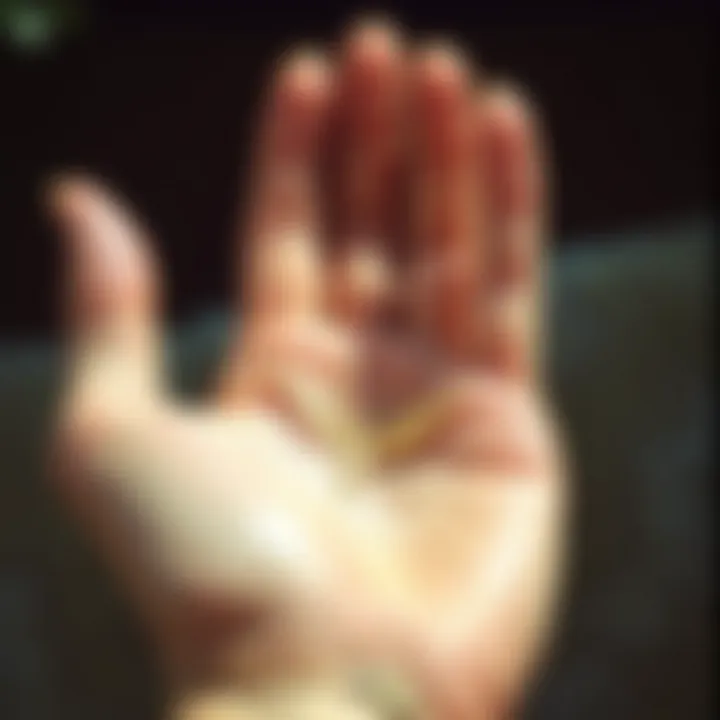Exploring the Palm: Anatomy, Symbolism, and Culture


Intro
The palm, often regarded as a mere component of human anatomy, holds profound significance that extends far beyond its basic physical structure. While we use our hands for countless daily tasks—from typing to cooking—the palm itself embodies a rich tapestry of meaning and interpretation. As one delves into the anatomy of the palm, they begin to uncover layers that connect physicality with intricate symbolic frameworks, cultural beliefs, and even astrological insights.
Understanding the palm requires not just an anatomical approach but also an exploration of how various cultures perceive and interpret its significance. Whether through the lens of palmistry, where lines and mounts are seen as indicators of one's life journey, or through astrological connections that assign traits and predictions based on the positions of celestial bodies, the palm appears to straddle both the tangible and the metaphysical.
This article aims to traverse this multifaceted terrain, guiding readers through the complexities of the palm’s anatomy, its rich symbolism across cultures, and its implications in fields such as astrology. By the end, one will not only have a clearer idea of the anatomy involved but also how these vast meanings influence personal growth and interpersonal connections in our daily lives.
Understanding Palm Anatomy
The palm, often overlooked in terms of its complexities, plays a pivotal role in both human anatomy and personal expression. Understanding the palm's structure goes beyond mere anatomy; it encapsulates both function and symbolism. Each component of the palm contributes significantly to its capacity to perform intricate actions, while also serving as a canvas for cultural and metaphysical interpretation.
Basic Structure of the Palm
The basic structure of the palm consists of several key components: bones, tendons, ligaments, and skin. The palm contains five metacarpal bones, which form the framework and support the hand's movements. These bones are connected to the phalanges, which create the fingers. The base of the palm is reinforced by a network of ligaments that help to stabilize and provide flexibility.
Moreover, tendons run along the inside of the palm, connecting the muscles of the forearm to the fingers, allowing for a wide range of motion.
In essence, the physical framework of the palm is designed not merely for strength but for precision and finesse, enabling performers, artists, and everyday individuals alike to wield power over even the slightest of motions.
Muscular System of the Palm
The muscular system of the palm is where the magic happens. It is comprised of intrinsic and extrinsic muscles. Intrinsic muscles originate within the hand itself, contributing to delicate movements such as gripping and pinching. Notably, the hypothenar and thenar muscles control the small yet significant functions of the little and thumb fingers, respectively. Extrinsic muscles, on the other hand, begin in the forearm and insert into the hand, providing strength for tasks that require a firmer grip or force.
Understanding these muscle groups is vital for anyone looking to grasp the mechanics of hand movements, and more importantly, for those interested in the nuances of palmistry. These muscles tell a story of skill and capability, contributing to both physical prowess and personal identity.
Nerve Endings and Sensation
The palm is rich in nerve endings, which serve as a sensory playground. These nerve endings make the palm extremely sensitive, allowing it to detect textures, temperatures, and even subtle vibrations. This sensitivity is crucial not only for daily tasks but also plays a significant role in emotional expression, communication, and interaction with the environment.
A mere touch can communicate emotions often more potent than words.
In terms of palmistry, the placement of these nerve endings gives readers insight into an individual's personality traits and emotional state. Understanding the complexity of these sensations can reveal how the hand functions as more than an anatomical structure; it acts as an emotional conduit.
Skin Texture and Variations
The skin on the palm, much thicker than on other parts of the body, serves significant protective functions. Variations exist based on genetics, environment, and personal habits. Some individuals may exhibit smoother skin, which can indicate sensitivity, while others might have more calloused palms, suggesting a hands-on lifestyle. These unique features can influence both daily interactions and interpretations in palmistry.
- Smooth skin often correlates with a gentle nature or artistic inclination.
- Calloused skin might suggest resilience, hard work, or practicality.
Understanding these variations not only adds depth to our grasp of palm anatomy but also offers a window into the lives led by those who carry those palms.
The Palm in Cultural Context
The palm is not merely a functional part of the human anatomy; it holds significant value across various cultures and societies. Its representation can be seen in art, literature, and even in spiritual practices. Understanding how different cultures interpret the palm opens up a fascinating dialogue about human expression and identity. This exploration functions as a bridge connecting physical anatomy with symbolic meaning, enriching our comprehension of what it is to be human.
Historical Perspectives on Palm Symbolism
Historically, the palm has been an important symbol in numerous civilizations. Ancient Egyptians used images of hands in their hieroglyphs, signifying strength and power. The palm was viewed as a symbol of protection and was often depicted in tomb paintings as a means of guiding the deceased into the afterlife.
In ancient Greece, hands were also considered significant; they would symbolize various virtues depending on their position and action. For instance, an open hand was seen as a representation of hospitality and generosity. Conversely, a fist might embody anger or resistance. This duality reflects the intricate nature of human expression, indicating that the palm's significance evolves across contexts and time.


Cultural Variants of Palm Interpretation
Every culture brings its own unique perspective to the meaning of the palm. In India, for example, the palm is viewed as a seat of spiritual energy. The concept of Chakras emphasizes the palm's role in the flow of energy throughout the body, tying it to holistic wellness.
In contrast, in many African cultures, the palm tree itself serves as a metaphor for life and growth, often used in various rituals and blessings. The close association of the palm with life in these traditions provides a lens for understanding how intertwined what we regard as mundane can be with our spiritual and cultural identities.
Religious Significance of the Palm
Religiously, the palm also carries substantial weight. In Christianity, the palm branch is an emblem of peace and victory, famously seen during Palm Sunday when Jesus entered Jerusalem. The palm's association with victory is mirrored in the traditions of other religions as well. For instance, in Islamic culture, the palm tree is often lauded for its resilience and ability to thrive in barren lands. This symbolism of survival and sustenance rings true across the globe, marking a shared reverence for the palm in both spiritual and practical contexts.
The palm thus transcends its physical presence, merging anatomy with rich cultural narratives that foster connection and understanding among diverse populations.
Palmistry: An Exploration
Palmistry, often linked to the mystical arts, serves as a portal into understanding not merely the self, but also how individuals interact with the world. This practice, widely celebrated across cultures, delves into the intricate lines and shapes found on the palm. Each curve and mark tells a story that, when deciphered, can provide insights into one’s personality, potential, and even future. This section sheds light on the significance of palmistry in both an anatomical and philosophical context, bridging the gap between the tangible and the abstract.
Origins and Evolution of Palmistry
The roots of palmistry can be traced back thousands of years to diverse civilizations. In ancient India, palmistry was a common practice among sages, believed to reveal spiritual truths such as destinies and life paths. The Greeks, particularly Aristotle, also took note of these tactile signs, merging them with their philosophical inquiries. This idea of mapping life through the palm traveled across continents, influencing various religious and cultural beliefs.
Key Milestones in the Evolution of Palmistry:
- India: Texts such as the 'Samhita' detail intricate interpretations of the lines and mounts found on the palm.
- Europe: During the Renaissance, palmistry gained a resurgence with scholars and thinkers experimenting with merging astrology and physical traits.
- Modern Era: Today, palmistry continues to evolve, often interacting with psychological insights about human behavior.
From mystical roots to modern interpretations, palmistry has maintained its allure as a tool for personal reflection and exploration.
Major Lines on the Palm and Their Meanings
Each hand possesses unique lines that serve as markers of experiences and traits. Understanding these lines is crucial for anyone interested in palmistry. The three primary lines—heart, head, and life—each have distinct implications:
- Heart Line: Signifies emotional wellbeing and relationships. A curved heart line suggests a warmth in relationships, while a straighter line may indicate a more reserved nature.
- Head Line: Represents intellect and reasoning. A long, deep head line implies strong analytical abilities, while a wavy line may suggest a more spontaneous and creative thought process.
- Life Line: Contrary to popular belief, this line does not predict longevity but indicates life’s vigor and experiences. A deeper line might suggest a robust vitality, whereas a faded line could reflect energy that hasn’t been fully realized.
Understanding these lines not only provides insight into personality traits but helps inform personal growth strategies.
Mounts and Their Significance
Mounts, or the fleshy pads beneath each finger, reveal nuances of character and temperament. Each mount corresponds to a different planetary influence, reflecting diverse aspects of life:
- Mount of Venus: Linked to love and affection. A pronounced mount could indicate a passionate nature.
- Mount of Jupiter: Associated with ambition and leadership. A well-developed mount may signify strong leadership qualities.
- Mount of Saturn: Resonates with discipline and responsibility. An inflated mount could suggest someone who takes life seriously.
The interplay between these mounts can illuminate deeper aspects of personal identity, assisting in self-discovery.
Reading Techniques for the Novice and Expert
When it comes to learning palmistry, there are varied techniques suited for both novices and seasoned practitioners:
- Start with the Basics: Familiarize yourself with the primary lines and mounts. Drawing your own palm with labels can be a fun and informative exercise.
- Practice Interpretations: Find a partner and practice reading each other’s palms, discussing interpretations based on auspicious and challenging aspects.
- Understand Context: Always consider the context of the reading. Emotional states and life situations can influence how to interpret a palm accurately.
For more experienced readers, deepening the connection with the subject can offer richer insights, integrating personal stories within the context of palmistry.
"A hand’s wisdom is a mirror to the soul’s journey."
Understanding these elements of palmistry not only encourages self-exploration but also enriches interpersonal connections. Engaging with palmistry can open up dialogues about personal experiences and sentiments, creating bonds forged in shared understanding.


The Palm in Astrology
When discussing the intricate relationship between astrology and the physical attributes of the palm, one finds a web woven from centuries of tradition and insight. The palm is not merely a fleshy part of the hand; it serves as a canvas that portrays individuality, emotional tendencies, and even cosmic influences. The importance of this theme in our exploration lies in the belief that the features of the palm can reflect one's astrological disposition, guiding both self-understanding and deeper connections with others.
Astrological Significance of Hand Features
The traits of hands, particularly the palms, have long been regarded as indicative of deeper astrological truths. Each line, mount, and shape can correlate with the planets and their positions at the time of one’s birth. For instance:
- Heart Line: Often linked to emotional health and relationships, it can show how one may experience love according to their astrological sign. A strong, clear line may suggest openness, whereas a wavy line could indicate tumultuous relationships.
- Head Line: This reflects one’s intellect and thought processes. The characteristics of the head line can suggest how someone approaches problem-solving based on their zodiac disposition.
- Life Line: While commonly mistaken as a marker of lifespan, the life line actually informs about the quality of life and energy levels. Astrologers often connect its depth and clarity with the vitality associated with specific signs, such as Aries or Taurus.
"Astrology sees the hand as part of the cosmic puzzle, each feature melding into a unique birth chart."
To fully grasp the significance of palm features, one must also consider the mounts, which are the raised areas of flesh on the palm. Each mount corresponds to a planet: for example, the mount of Venus speaks to love and passion (akin to the sign of Libra), while the mount of Jupiter relates to ambition and leadership (associated with Capricorn). Understanding these connections can bolster personal introspection, helping individuals align their efforts with their inherent attributes dictated by their astrological signs.
Connecting Palmistry and Zodiac Signs
The intertwining of palmistry and zodiac signs provides a fascinating framework for understanding oneself and others. Each of the twelve signs carries distinct characteristics that can be illustrated through palms. Here’s a brief outline of how significant traits link to each zodiac sign:
- Aries: Impulsive and enthusiastic, often reflected in the depth of their life line, showing their innate vitality.
- Taurus: Practical and reliable, with a strong heart line symbolizing their profound emotional connections.
- Gemini: Versatile and communicative, evident in their flexible, often double head line, depicting their dual nature.
- Cancer: Nurturing and sensitive, frequently shown in the curvature of their heart line that indicates deep familial ties.
- Leo: Charismatic and confident, with prominent mounts of Jupiter and Venus suggestive of their leadership qualities.
- Virgo: Analytical and detail-oriented, often showcased in their precise head line and well-defined mounts.
- Libra: Balanced and partnership-focused, marked by even lines and symmetry in the hand.
- Scorpio: Intense and mysterious, indicated by more complex patterns in their palm lines.
- Sagittarius: Adventurous and optimistic, characterized by open, expansive lines suggesting freedom of spirit.
- Capricorn: Disciplined and pragmatic, often represented by strong, clear lines showcasing their focus and ambition.
- Aquarius: Innovative and intellectual, visible in the unique shape of their palm, reflecting their unconventional ideas.
- Pisces: Compassionate and intuitive, articulated through fluid lines and a soft palm texture that conveys sensitivity.
Each sign narrates its story through the unique features of the palm, making the exploration of palmistry and astrology a truly enriching endeavor. Unraveling the language of the hand may just help individuals navigate their paths effectively, fostering understanding in personal and interpersonal realms.
Resources for further exploration:
As one delves deeper into these interconnected forms of wisdom, the potential to harness personal insights becomes not only possible, but profoundly enriching.
The Psychosocial Impact of the Palm
The palm holds significant sway over various aspects of human life, acting as a bridge between our physical presence and social identities. Understanding the psychosocial impact of the palm transcends mere anatomy; it delves into how our hands—particularly the palm—affect our interactions and self-perception. The fingers may do the talking, but it’s often the palms that convey a deeper layer of meaning and connection.
Palmistry and Personal Identity
In the realm of palmistry, individuals often find a reflection of their inner selves expressed through the lines and shapes of their palms. This practice provides insights not only into personality traits but also into life experiences and potential futures. By examining the unique characteristics of one’s palm, individuals may identify strengths, weaknesses, and personal life paths that resonant with their true identity.
Moreover, the sense of ownership over this personal “map” can boost self-esteem and encourage personal growth. As people explore their palms in relation to their identity, they often report a feeling of empowerment, unlocking aspects of themselves that had previously remained dormant. This willingness to engage with the physical manifestation of their being—represented by the palm—can lead to a newfound appreciation for the complexities of life.
“The palm tells stories no words can express.”
Hands as Tools of Connection and Communication
Hands are not just tools for manual tasks; they are essential in establishing social bonds and conveying emotions. The palm, in particular, plays a key role in non-verbal communication, as gestures made with hands can express everything from enthusiasm to discomfort. A friendly wave or a tender touch can initiate connections that words alone might never achieve.
When people engage in palm-to-palm contact, like a handshake or a comforting grip, they are not merely exchanging physical touch; they are implementing a powerful connection that transcends verbal language. This tactile communication can enhance relationships, creating an atmosphere of trust and empathy.
Here are a few functions of hands that highlight their communicative power:
- Gestures: Using hand movements to emphasize points or express emotions.
- Non-verbal cues: Communicating feelings like openness or defensiveness through palm positioning.
- Social rituals: Engaging in received norms such as greeting or farewells through touch, which can foster community.
In a world where digital communication often eclipses face-to-face interaction, the tactile nature of our palms serves as a reminder that some connections go beyond the superficial. In essence, every gesture, every touch made by the palm holds the potential to shape relationships and influence emotional landscapes.


Practical Applications of Palm Insights
The study of palms extends beyond mere anatomy; it intertwines with personal growth and interpersonal dynamics. Recognizing the relevance of palm insights leads us to explore not just what the palm reveals about us but how we can engage with that knowledge for transformative purposes. Whether you’re a hardcore astrology enthusiast or simply intrigued by hand analysis, the ability to apply these insights can significantly enhance various aspects of life.
Palmistry isn't just about fate or hidden messages; it serves as a reflective tool. The lines, shapes, and even the texture of your palm can point to certain tendencies and attributes. Understanding these can foster personal growth. For instance, realize that your heart line might suggest your emotional approach to relationships. Armed with this knowledge, one can learn to navigate their feelings and nurture emotional intelligence.
Using Palmistry for Personal Growth
Using palmistry for self-reflection can be a game changer. By examining the lines on your palm, you might uncover aspects of your character that are both strengths and weaknesses. It is imperative to engage with this knowledge thoughtfully.
- Identifying Strengths and Weaknesses: The life line illustrates vitality, while the head line reveals cerebral attributes. Recognizing these can provide clarity. For example, if your head line is long and straight, you may possess strong analytical skills. In contrast, a wavy line suggests a creative thinker. Knowing these traits can help you harness your strengths or work on your weaknesses.
- Setting Personal Goals: With insights gained from palmistry, you can set realistic, achievable goals. Maybe your palm indicates a knack for leadership—use that to pursue opportunities in management or network-building.
- Emotional Awareness: The heart line can reveal how you connect with people emotionally. Understanding whether you are open or reserved in your emotional expressions can encourage you to become more attuned to your interactions.
Engaging with palmistry as a tool for personal insight doesn't mean you abandon other forms of introspection. Rather, it complements techniques like journaling or meditation with a tactile, visual approach.
Integrating Palm Insight into Relationship Dynamics
When it comes to relationships, understanding one’s own palm—and by extension, those of partners or friends—can lead to deeper connections. It’s not simply about deciphering someone’s future; it's about enhancing the present interactions.
- Reading Partner’s Palms: By integrating palm insights in relationships, we can recognize behavioral patterns. An understanding of your partner's emotional lines can clarify how they approach affection or conflict. If their heart line shows tendencies towards depth, perhaps they appreciate heartfelt discussions more than surface-level small talk.
- Balancing Differences: Recognizing that each palm tells a different story allows for the appreciation of individual quirks and behaviors. It promotes harmony to realize that, perhaps, your partner needs more emotional validation based on their palm’s characteristics, while you might prioritize intellectual discussions.
- Building Communication: The interplay of different palm characteristics between partners can encourage better communication. For instance, someone with shorter fingers may prefer direct communication, while another with longer fingers may value nuance. Having this awareness allows conversations to flow smoothly, reducing misunderstandings.
In sum, the significance of the palm extends beyond anatomical intrigue; it enriches personal development and cultivates deeper relationships. The palm holds not just the story of our hands but perhaps a narrative of our lives waiting to be explored.
"Each line tells a story, and every curve holds a secret. Learning to read those tales can significantly alter your path."
For further reading on palmistry, you might check resources at Wikipedia or delve into community discussions on Reddit.
Engage with the inner workings of self and others, letting the palm be your guide.
Future Research Directions
As we delve into the palm's multifaceted significance, it becomes apparent that both palms and hands are more than just tools for practical engagement; they embody complex narratives tied to anatomy, culture, and human expression. Researching future directions in hand and palm studies holds immense promise, shedding light on aspects previously enthralled by mystery and superstition. Understanding the palm can lead to broader implications in various domains, from psychology to sociology, and even health sciences.
In the world of palmistry, scholars are beginning to merge traditional methodologies with modern techniques. For instance, there’s a growing interest in empirical studies that intertwine psychology with palm reading. This isn’t just about evaluating the shape of the palm or the length of the fingers; it’s about understanding how these features correlate with personality traits and behavioral tendencies.
Meanwhile, the growing field of genetic studies also offers exciting possibilities. As science progresses, we may uncover how biological factors influence hand morphology, which in turn might have implications in both palmistry and medical fields. Could there be a genetic link that predisposes individuals to certain personality characteristics as indicated by their palm structure? This intersection of genetics and the metaphysical might prompt fresh debates, ultimately generating insight that could challenge conventional beliefs.
Moreover, as technology advances, new tools and instruments equipped with data analytics can help researchers validate traditional palmistry claims. Digital platforms could be developed where users can upload images of their palms for analysis. This would not only democratize palmistry but could also enrich academic research.
“With the right tools and research direction, the understanding of palms could shift from mystical interpretations to scientifically backed insights.”
The field must also contemplate ethical implications associated with palm studies. As we sharpen our focus on the interconnectedness of the palm with personal identity and cognition, it remains crucial to address how this knowledge might be employed responsibly.
Emerging Trends in Palmistry Studies
Recent years have seen a notable resurgence in palmistry, with a fusion of ancient wisdom and modern sensibilities. People are increasingly seeking personal insights related to their identities, relationships, and futures. Assessing these trends reveals significant interests:
- Digital Palmistry: Online platforms, social media, and apps are changing how knowledge is shared. By connecting experts and enthusiasts, they provide a space for community learning.
- Astrological Integrations: More individuals are exploring how palm features interact with their astrological profiles. This holistic approach holds sway among astrology enthusiasts eager to weave their palm readings into a larger cosmic narrative.
- Workshops and Courses: A growing number of workshops, both in-person and virtual, are designed to teach this arcane art. New learners are guided not just through traditional methods, but often encouraged to intertwine their own experiences.
These emerging trends invite fresh questions about how palmistry can be adapted. Will skepticism fade as more people engage with palm reading? It’s an open question that researchers can delve into further.
Advancements in Hand Anatomy Research
The scientific community continuously seeks to decode the complexities of hand and palm anatomy. Recent advancements are shedding light on how anatomy correlates with practical applications in various fields:
- Biomechanical Analysis: New technologies are enabling in-depth studies of hand movements and grips. This aids not just ergonomics but also rehabilitative practices.
- 3D Imaging Technology: The use of 3D modeling can now provide more accurate insights into palm features, allowing researchers to compare variances across different populations.
- Neuroscientific Insights: Research is increasingly employing brain imaging to comprehend how sensory feedback from the palm influences cognitive processes. Understanding this relationship is critical in both health-related fields and cognitive psychology.
Such advancements emphasize the importance of an interdisciplinary approach to palm and hand studies. By harmonizing anatomical research with cultural interpretations, scholars can foster a more robust understanding of the palm as a physical and symbolic entity.
In closing, exploring these future research directions in palm studies not only enriches our understanding but also challenges established narratives, leading to deeper insights into human identity, connection, and expression.







